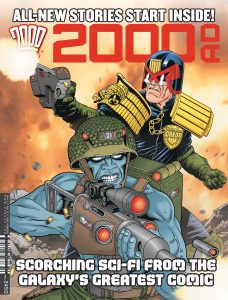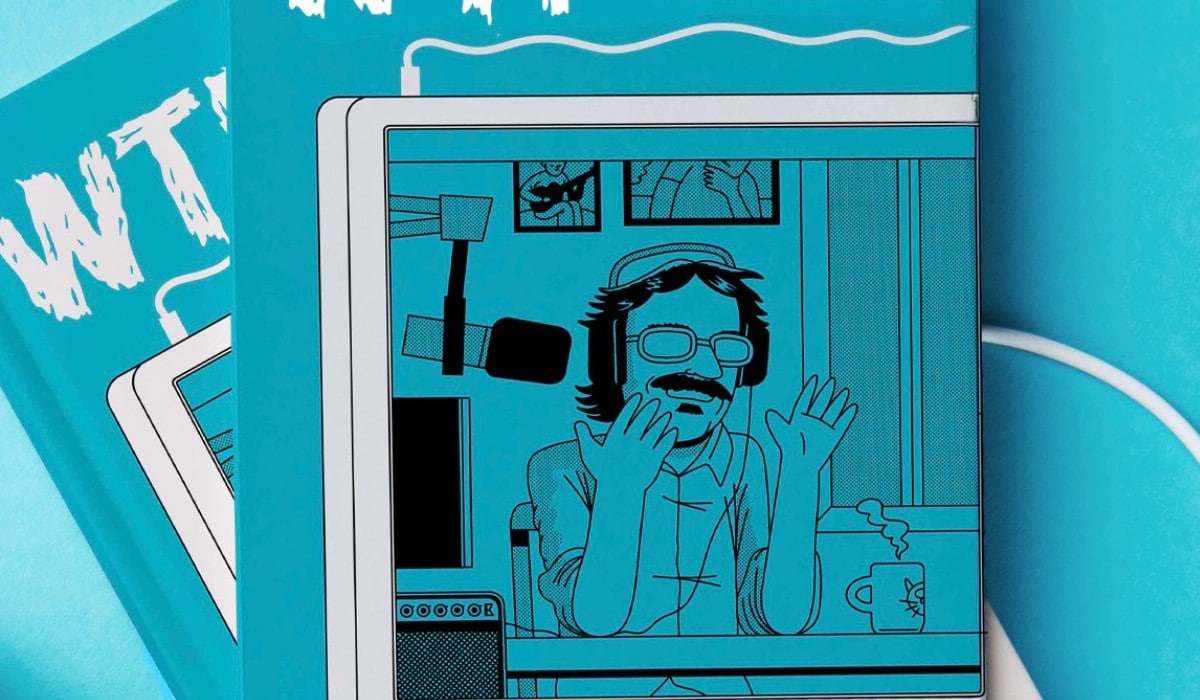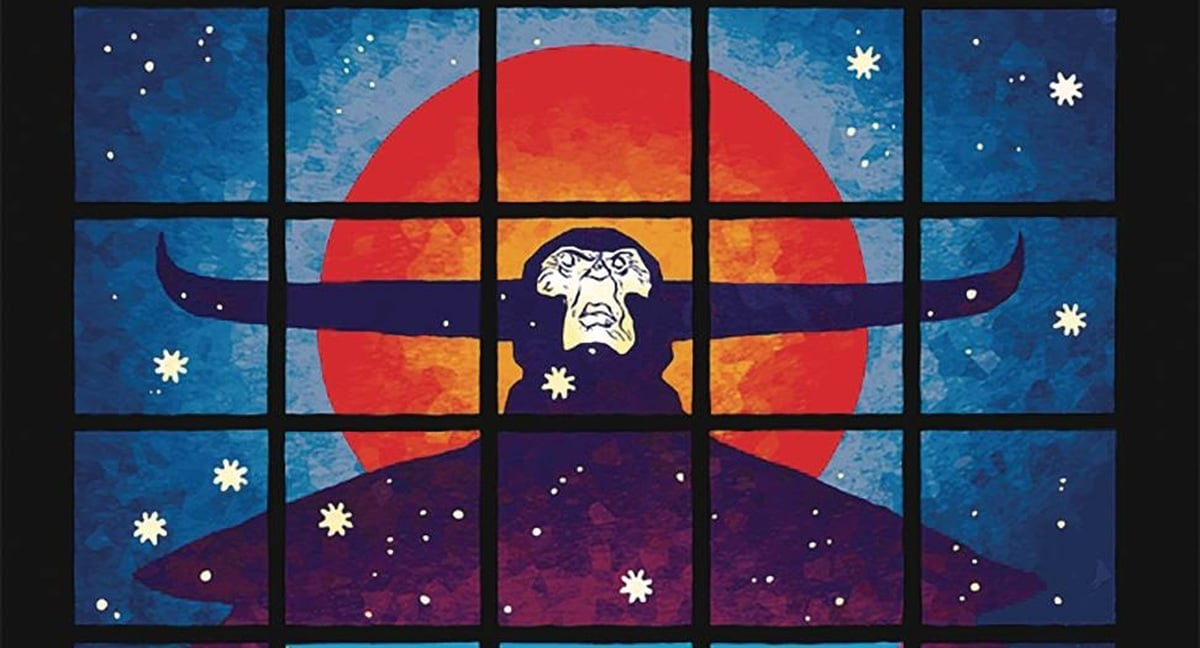When The Prog 2450 hits next week, it will feature the first chapter of a new Judge Dredd story arc by writer Rob Williams, artist Henry Flint, and letterer Annie Parkhouse.
 This, of course, is the same team that last year made one of my personal favorite comics of the year, Judge Dredd: A Better World. This new arc, however, promises to be very different, if the first chapter (which I got an advanced look at) is any indication.
This, of course, is the same team that last year made one of my personal favorite comics of the year, Judge Dredd: A Better World. This new arc, however, promises to be very different, if the first chapter (which I got an advanced look at) is any indication.
Titled And to the Sea Return, it’s a horror story with a dark mystery at its center, and it’s set on The Barge, a terrifying floating prison that moves around this world’s Black Atlantic. The first chapter reveals just enough to tantalize and to chill. And I recently had a chance to ask Williams and Flint some questions about it.
You can find our conversation below, ahead of Prog 2450 arriving next week…enjoy!
Interview: Williams and Flint discuss their new story in PROG 2450
THE BEAT: Was there anything specific that inspired this new horror-at-sea story, and if so what was it?
Rob Williams: Henry Flint was just finishing up our Judge Dredd story ‘A Better World’ and I asked him what he fancied doing next. ‘A horror?’ That was it really.
Henry, for my money, is one of the best storytellers we have in comics and he did such incredible, innovative work on ‘A Better World.’ I wanted to keep him rolling on something he’d be invested in. ‘A Better World’ was a political thriller, really.
You want to keep things fresh and one of the wonderful things about Judge Dredd during his 48 year run is that the strip can include any story genre – comedy, action thriller, sci-fi, horror. This one is definitely a horror tale.
HENRY FLINT: We thought it would be fun to go for a horror story as, from my point of view, it would be bookended either side by two political thrillers. So purely for my benefit, we thought drawing something completely different would be a good break. We both love folk horror.
I live in a small Devonshire seaside town so Rob thought folk horror by the sea might suit me better. He gathered up lots of sea folk tropes and mixed in the most northerly point of the Mega-City, broken and falling into the sea. Rob has a great way of knowing what I want to do before I know it myself. He’s good like that, always finding the strengths in artists.
I can’t compete with horror masters like Dave Kendall and Nick Percival but hopefully will find a way. Hopefully it’ll be more Lovecraft than Scooby Doo, we’ll see.
THE BEAT: Are there any other past Dredd stories you’d recommend reading or revisiting before jumping into this one?
RW: Not especially. Nothing you need to read to understand this one. You can come in on the ground floor here easily enough. If you want some cool Dredd horror stories though, try Judge Death, The Dark Judges, City Of The Damned, The Haunting of Iso Block 9 – to name a few.
THE BEAT: You’ve written lots of different types of stories with Dredd. What makes him so flexible and adaptable for different genres and types of comics?
RW: It’s the world that John Wagner, Carlos Ezquerra, Alan Grant and co created. It’s so rich and varied, and when you were a kid you didn’t know what you were getting one week to the next. I think my first weekly 2000 AD order Dredd story was ‘League of Fatties’ which was a satire on obesity in society. Dredd always had the uncanny knack of predicting future trends.
HF: John Wagner was always able to twist any genre and adapt it to fit a Judge Dredd story. By doing so changes Dredd’s personality somewhat. Dredd can play both the bad guy and the good guy. In an adventure story Dredd usually plays the good guy, Rob plays with that too. I particularly like drawing Dredd as the hero as those were the stories that captured my imagination when I was a kid.
RW: In ‘A Better World’ we dealt with themes like the rise of fascism and billionaires’ influence on society. I guess you could say there’s a Climate Emergency theme in ‘And To The Sea Return’, but at the end of the day this one is just a good gruesome horror tale.
THE BEAT: You and Henry Flint have collaborated on quite a few Judge Dredd stories at this point, including this new one (obviously). How has the collaborative relationship changed over the time you’ve worked together?
RW: Every collaborative relationship with an artist is different. When I work with people like Laurence Campbell, PJ Holden and Pye Parr, they’ll send me breakdowns and we talk them through a little. Sometimes I’ll offer suggestions on changes before they go to pencils and inks.
With Henry I send the script to the editor, Matt Smith, then eventually Henry’s finished, coloured pages come through. And they’re always spectacular. He’s something of a savant when it comes to comics storytelling. With ‘A Better World’ he asked if Arthur Wyatt and I minded if he took our scripts and broken them down incrementally. So, for instance, a six panel page in the script could come back drawn as a 12 panel page. Exactly the same storytelling beats as described, just broken down into small storytelling increments.
I’ve worked with Henry so often I had confidence he’d deliver the story and it turned out beautifully. I think his work on that GN deserved an Eisner. He’s taking the same approach with ‘And To The Sea Return.’ And his colours are pretty incredible too.
HF: Rob has always been very encouraging with the way I do things. He can accommodate some of my stranger behaviours in drawing. An example would be allowing me to spread his dialogue over multiple panels. Rob’s been very helpful exploring these different types of storytelling. His work is full of intrigue and good solid pacing which only makes my job easier. Every time he comes up with something new I’m genuinely excited with the possibilities.
THE BEAT: We kind of get dropped into the middle of something horrific in the last two pages of this strip. How did you decide what to show the readers in that sequence and what to withhold?
HF: Ha ha, you can’t give too much away, especially in a horror story! There has to be some mystery. Rob’s quite rightly thrown in lots of unanswered questions and I’ve half drawn some unfinished images. More will be revealed soon.
RW: I find first episodes the easiest thing to write – all the hard work goes elsewhere. You have to know what’s coming, tease it out, have a big cliffhanger – in this case a gruesome, disturbing one. I think the tough thing on episode one of ‘And To The Sea Return’ was the setup exposition scene between Judge Dredd and Chief Judge Logan.
That kind of scene could’ve easily been really dull, but the dialogue and interplay between the two of them came out really well, and Henry drew the Justice Department Control Room so it all just shines. There’s a couple of really good lines from Dredd there.
THE BEAT: Finally, what was your personal worst experience at sea…or if not at sea, then on a beach, shore, or pier?
RW: Couple of sea-sickness moments. Hardly anything to write a sea-shanty about. A few weeks ago me and the family were in Mallorca, Spain, on holiday. We took a catamaran out at dawn to see some dolphins. By the time we reached them I’d turned green and couldn’t have cared less. Get me back on shore, quick.
Actually, there must be something in the writing water for me right now. I should mention that my Hellboy mini-series with Laurence Campbell (due out in November) has a nautical theme too – The Ghost Ships Of Labrador. Avast, etc.
HF: Too many to mention. Having been brought up by the sea I’ve many stories. I’ve swam against a rip current, not fun. As a five-year-old I bobbed up and down in the sea after my Dad’s dinghy capsized. While swimming I broke my foot kicking a rock just below the surface. One time I tried to see how far I could swim straight down and burst my eardrum.
Or the time as a kid with a mate collecting mussels in a bucket. We were caught out by the tide, trapped on a sandbank we had to swim back to shore, me holding the bucket above my head. The water was crystal clear, I could see thousands of black crabs crawling underneath me on the seabed, moving in one direction with the incoming tide, an amazing sight. I told my mate to look down. He did, panicked and almost drowned. A passerby pulled him out.
Then we ate the mussels and he got food poisoning. Funnily enough I didn’t see much of him after that.
Prog 2450 is out this Wednesday via 2000AD
Catch The Beat’s Prog Report featured every week in Wednesday Comics Reviews!
























 English (US) ·
English (US) ·